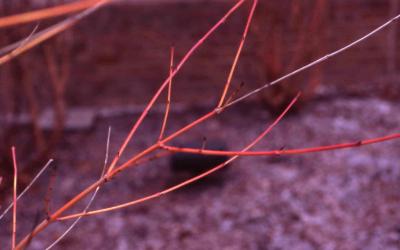Shrub
Bloodtwig Dogwood
Cornus sanguinea

Bloodtwig Dogwood, winter stems of the cultivar 'Winter Beauty'
Features
Creamy white flowers with an unpleasant fragrance, in flat topped clusters in late spring; purplish black fruit in late summer (often hidden by foliage); autumn color is purple to red; winter stems are a mix of green and red (not as effective as other dogwoods).
Culture
Full sun to partial shade; prefers a moist, well drained soil; tolerates alkaline soil.
Cultivars
- 'Winter Flame'- winter stems are orange yellow at the base and pinkish red at the ends, autumn color is yellow, 8-10 feet tall.
Mature Height
6-15 Feet
Size
Medium
Large
Mature Width
6-15 Feet
(or wider, due to suckering)
Mature Form
Irregular, suckers to form colonies
Native To:
Europe
USDA Hardiness Zone
4 - 7
Soil Conditions
Moist, Well-Drained
Tolerance
Alkaline Soil
Wind
Exposure/Light Requirements
Full Sun
Partial Sun/Shade
Uses
Massing
Naturalizing
Screen
Foliage Color
Green
Fall Foliage Color
Purple
Red
Pests and Problems
Environmental Damage
Fungal Disease
Additional pests and problems that may affect this plant:
This shrub has potential to form thickets and pruning may be needed to keep a desirable shape.
Additional Notes
Related Resources
Home, Yard & Garden Pest Guide
The Home, Yard & Garden Pest Guide (C1391) provides is written for homeowners and other residents and provides nonchemical and current chemical recommendations for controlling pests associated with trees, shrubs, turf, flowers, groundcovers, vegetables, fruit, and houses. In addition, you'll find detailed information about integrated pest management, pesticide safety, and pesticide application and calibration techniques. This publication may be purchased at your local University of Illinois Extension Unit office, or by calling 800-345-6087, or by placing an order online (search for "C1391").
Visit site >>
Illinois Commercial Landscape and Turfgrass Pest Management Handbook
The Illinois Commercial Landscape and Turfgrass Pest Management Handbook (ICLT) is written for professional applicators and provides nonchemical and current chemical recommendations as well as application timing information for all major pests of turf, woody ornamentals and herbaceous ornamentals. This publication may be purchased at your local University of Illinois Extension Unit office, or by calling 800-345-6087, or by placing an order online (search for "ICLT").
Visit site >>
U of IL - Distance Diagnosis through Digital Imaging
A free plant, weed, insect and disease identification service available through your local University of Illinois Extension office. Center Educators or State Specialists review & respond to information and digital images submitted by local Extension office personnel. Some samples may require further examination or culture work (nominal fee involved) at the U of IL Plant Clinic.
Visit site >>
U of IL - Plant Clinic
Services include plant and insect identification, diagnosis of disease, insect, weed and chemical injury (chemical injury on field crops only), nematode assays, and help with nutrient related problems, as well as recommendations involving these diagnoses. Microscopic examinations, laboratory culturing, virus assays, and nematode assays are some of the techniques used in the clinic.
Visit site >>
